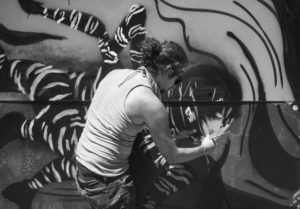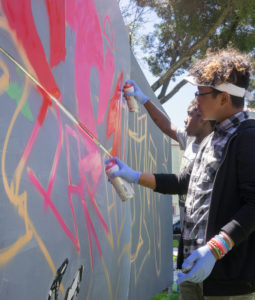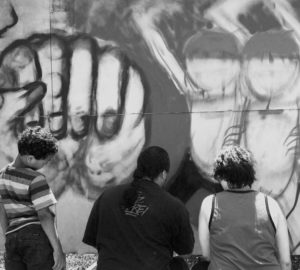Through the Lens: Graffiti in the Age of Resistance
The theme of the day was skepticism and anonymity. Kids of all ages and races held spray cans and paintbrushes. Adults taught the finer points of mural painting, from quick, narrow strokes to rich, saturated colors. Wooden billboard-size canvasses stood in Precita Park, waiting for anyone who dared to try their luck at a new […]
 The theme of the day was skepticism and anonymity. Kids of all ages and races held spray cans and paintbrushes. Adults taught the finer points of mural painting, from quick, narrow strokes to rich, saturated colors. Wooden billboard-size canvasses stood in Precita Park, waiting for anyone who dared to try their luck at a new artistic medium. The 2017 Urban Youth Arts Festival promised to be an introspective look into the multifaceted art form that is graffiti. Accessible to all, it was an opportunity for the amateur to try their hand at writing their own nickname or drawing a picture for everyone to admire.
The theme of the day was skepticism and anonymity. Kids of all ages and races held spray cans and paintbrushes. Adults taught the finer points of mural painting, from quick, narrow strokes to rich, saturated colors. Wooden billboard-size canvasses stood in Precita Park, waiting for anyone who dared to try their luck at a new artistic medium. The 2017 Urban Youth Arts Festival promised to be an introspective look into the multifaceted art form that is graffiti. Accessible to all, it was an opportunity for the amateur to try their hand at writing their own nickname or drawing a picture for everyone to admire.
“Why are you taking photos?” asked one man wearing a long t-shirt caked with dried paint, suspicious of anyone’s intentions with a camera. After a brief moment of overt hostility, he pointed at the mural he was working on with a group of five or six kids. The artwork, he said, was “social justice through spray paint.” He stated that it was a community project involving kids in the Bayview district of the city, designed to give them an outlet to safely express themselves and stay on the right path. The kids, seemingly ignorant of the mural’s mission, were just happy to put colorful paint on canvas.
A community director at the Bayview YMCA watched as the center’s art program director, known only as “E,” stood in front of his mural and critiqued his students’ technique. She told me that graffiti has been around since the 1980s. It was not intended to be a harbinger of violence, but rather a symbol of the downtrodden neighborhoods that play host to the murals, quickly-drawn nickname bombs, and bubble art of generations of urban youth. “It’s like any other artistic movement, impressionism or otherwise,” she said before running off, leaving E to tend to the mural and kids. “With spray paint you gotta take it one finger at a time,” E said as his student picked up two cans of paint and asked him what to do next. Bystanders continued to watch for over an hour as this piece, which took over a week to plan, came to life.
 Walking from one canvas to another, hostility and skepticism grew steadily, and the tone of the event changed abruptly. One artist, who spoke on condition of anonymity, gave no indication of letting his guard down at any point during many encounters with onlookers. This man, in his early thirties, mentioned that he had been drawing since the age of 6. He was inspired by the Teenage Mutant Ninja Turtles and their ability to enthrall entire generations of young kids, to make people believe the unbelievable through striking illustration. Having started with crayons at a young age, he graduated to paint. “Crappy paint, because I’m broke,” he sneered. “Graffiti is hip hop”, he said, becoming increasingly irate. It started out as a way for people to “claim territory” and take pride in their upbringing. It started in the alleyways and stoops of such cities as New York and San Francisco, and soon spread to worldwide popularity, as urban youth all over the world began writing their nicknames on the walls of their neighborhoods. Over the last decade, well-known, even infamous artists such as Banksy have helped legitimize the graffiti and street art culture by cultivating a level of counter-culture mystique and sparking dialogue, without inciting violence through their art.
Walking from one canvas to another, hostility and skepticism grew steadily, and the tone of the event changed abruptly. One artist, who spoke on condition of anonymity, gave no indication of letting his guard down at any point during many encounters with onlookers. This man, in his early thirties, mentioned that he had been drawing since the age of 6. He was inspired by the Teenage Mutant Ninja Turtles and their ability to enthrall entire generations of young kids, to make people believe the unbelievable through striking illustration. Having started with crayons at a young age, he graduated to paint. “Crappy paint, because I’m broke,” he sneered. “Graffiti is hip hop”, he said, becoming increasingly irate. It started out as a way for people to “claim territory” and take pride in their upbringing. It started in the alleyways and stoops of such cities as New York and San Francisco, and soon spread to worldwide popularity, as urban youth all over the world began writing their nicknames on the walls of their neighborhoods. Over the last decade, well-known, even infamous artists such as Banksy have helped legitimize the graffiti and street art culture by cultivating a level of counter-culture mystique and sparking dialogue, without inciting violence through their art.
Without turning away from his painting of what looked to be a cross between a homicide chalk-sketch and an octopus, he pointed behind him to a billboard of nickname bombs, saying that graffiti does not have to be violent – it is merely a grittier form of art. Growing up, many urban youth did not have an upbringing that exposed them to classical art forms, whereas graffiti was both accessible and representative of their unique backgrounds. By writing their chosen street names on neighborhood walls, people expressed themselves artistically with intricate designs, all while staking their claim in neighborhood history for future generations.
His wariness, he said, was due to the bad stigma placed on graffiti as neighborhoods became prone to gang violence, and graffiti became associated with violent messages and scratched out names of dead or hunted rival gang members.
Suddenly, the microphone crackled on stage. “The theme of the festival is resistance,” said the event DJ as the crowd began to change. Many of the families that had brought their kids at the beginning of the event could be seen quickly packing up and leaving, as the tone for the rest of the evening was set. Community members were invited onstage to speak, read poetry, and spread the message of opposition. The vitriol grew, as intricate canvasses were replaced by monologues about American whitewashing and oppression, calm murmurs replaced by shouting.
 The event, like so many other media, became a space for seeding division. Instead of speeches encouraging urban youth to channel their thoughts onto a canvas and stay on the path to success, speakers and poets, one after another, used the gritty nature of the graffiti art form for the furtherance of an agenda that trivialized and enabled potential bloodshed. While art has long been used to illustrate opinion, political and otherwise, should art not speak for itself? This event had the potential to bring together people, families of all backgrounds, to grow an appreciation for an often misunderstood art form, to learn from such skilled masters as “E.” Instead, it became just another victory point for divisive revolution rather than diplomatic cultural dialogue and exchange.
The event, like so many other media, became a space for seeding division. Instead of speeches encouraging urban youth to channel their thoughts onto a canvas and stay on the path to success, speakers and poets, one after another, used the gritty nature of the graffiti art form for the furtherance of an agenda that trivialized and enabled potential bloodshed. While art has long been used to illustrate opinion, political and otherwise, should art not speak for itself? This event had the potential to bring together people, families of all backgrounds, to grow an appreciation for an often misunderstood art form, to learn from such skilled masters as “E.” Instead, it became just another victory point for divisive revolution rather than diplomatic cultural dialogue and exchange.
With tourists and locals flocking to a city well-known for its iconic alleys filled with charming European scenes and impressive street art, it comes as no surprise that the Urban Youth Art Festival would draw a diverse crowd – curious onlookers and revolutionaries alike.
It is undeniable that graffiti is inherently more political than other art forms; the very act itself of putting spray can to brick, an illegal act done with intention, could be interpreted as political. However, the festival was intended to be an artistic showcase, meant to fight stigma by elevating the art form and its practitioners in the public’s eyes. Instead, the speakers portrayed their divisive messages as the unanimous voice of a diverse community. Though claiming to speak for diversity, they undermined it.
Photos by Ilya Faynshteyn
Ilya is not good at standing still. He enjoys long-haul flights to exotic unknowns, getting lost in bustling cities, navigating language barriers, and haggling for unique items.
Ilya is a graduate of the George Washington University in Washington D.C, where he received a master’s degree in Safety & Security studies.





